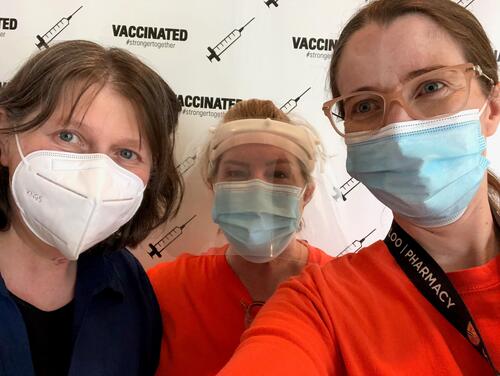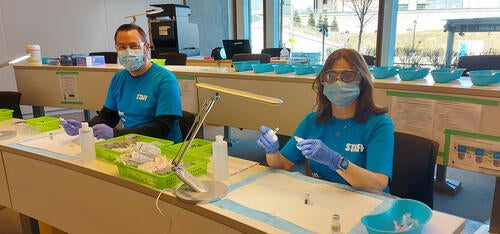
How to turn a classroom into a vaccine clinic
For much of 2021, Waterloo collaborated with local partners to run a busy regional vaccine clinic

For much of 2021, Waterloo collaborated with local partners to run a busy regional vaccine clinic
By Alana Rigby School of PharmacyIn late February, the Region needed a vaccine clinic to serve downtown Kitchener. Joe Lee and the Centre for Family Medicine (CFFM) stepped forward. When it came to finding an appropriate location, CFFM asked their neighbour, the School of Pharmacy.
“The word ‘no’ isn’t in our vocabulary,” says Trenny McGinnis, pharmacy’s administrative officer. “Our executive team had already implemented changes to support the vaccine effort, from injection-training students earlier in the program to creating COVID educational materials. Partnering on a clinic was a logical next step.”
The clinic was expected to open in March, but transforming the pharmacy school, located on the Health Sciences Campus (HSC), into a health-care space in that time was a daunting task. A team from the School of Pharmacy, including Nancy Waite, Kelly Grindrod, Brett Barrett and Ken Manson, got to work, researching existing vaccine clinics and visiting the Grand River Hospital clinic for ideas.
“We took what we learned and looked at our space,” Waite says. “We conducted a walk through with our partners at CFFM, and at the end we turned to each other and said, with a mix of surprise and trepidation, ‘I think this could work!’”
The days following were a flurry of activity. Andrea Edginton, School of Pharmacy Hallman Director, worked with the University of Waterloo to secure approvals for the clinic. Charmaine Dean, the University’s Vice President, Research and International, led development of the agreement between the Region and the University that allowed the clinic to operate. Many teams from different units put in long days and evenings finalizing the agreement and ensuring that the space met safety and logistical requirements.
“This collaboration was important because of our university’s commitment to supporting a variety of needs related to COVID issues we faced here in Kitchener-Waterloo,” says Dean. “From the beginning, we worked with the community, to supply laboratory supplies, personnel with specialized skills, and, in this case, to rise to the occasion to bring vaccines to our community.”
With approvals in place and partners on board, the CFFM and the University team had a goal: design, staff and open the clinic by March 15, just two weeks after the request came in.
New signage, the removal and addition of furniture, panels that would demarcate clinic space and school space, building access, parking and vaccine storage at the right temperature; these were just some of the logistical requirements for opening the clinic.
“I’ve worked at the University for forty years and in eight different units,” McGinnis says. “I called every team and person I knew who could help us get what we needed to prepare the space. Everyone I reached out to was eager to help.”
With assistance from Plant Operations, the WatCard Office, Creative Services and other departments, the team rallied to make the transformation happen.
Hallways and atriums were converted into check-in stations and waiting areas. Classrooms and study rooms were set up for injection preparation and vaccine administration.
“We’d never envisioned our building being used this way,” McGinnis says. “But it was perfectly suited. We have a long corridor and multiple entrances for rooms, allowing for one-way traffic all on one floor. This was an exciting opportunity to serve our community and showcase our school and our people.”

Marianna Foldvari, professor, Trenny McGinnis, administrative officer and Cynthia Richard, professor take a photo in their PPE at the clinic.
“I don’t think any of us realized how many people it would take,” says Nancy Waite, the pharmacy professor responsible for recruiting the clinic’s pharmacy team. “Not until we mapped out what was required for each task.”
Hiring and staffing was challenging, but the team received hundreds of applications. Screening and training were ongoing, and the team learned as they went.
“Our first shift we did 180 doses,” Waite says. “I remember thinking ‘how on earth are we going to do the 700 to 800 a day that was planned?’”
But the next week they were up to 430 doses, then 618 the following week. Though vaccine supply fluctuated early on, the clinic eventually grew to administering between 700 and 800 doses a day. The final count? 78,765 doses given between March 15 and August 13.
The pharmacy team prepared doses and managed vaccine. With Pfizer, doses must be used the within six hours of being prepared, and it was up to the pharmacy and clinic lead to decide — based on appointments, walk-ins and no shows — when and whether to open the next vial.
“Getting to work alongside students was inspiring,” Waite says. “Seeing and working with university colleagues in the role of pharmacists or pharmacy technician was a great bonding experience. Our relationships will never be the same.”

Ken Manson, pharmacist and School of Pharmacy staff, and Nancy Waite, professor, prepare vaccinations for K-W community members.
“I’m never going to look at our building the same way,” McGinnis says. “This was an incredible collaboration with the CFFM and the Region, and I am so proud of our commitment to making the clinic happen.”
Now that the Health Sciences Campus Clinic has closed, pride is a common sentiment among staff and volunteers, but so too is the humility that comes from supporting others:
“It was a privilege to be able to do this,” Waite says. “To see a patient’s relief and a few happy dances after their shots, and to work in our space, with our people and our neighbours. The clinic gave us an opportunity to help put an end to this pandemic.”

Read more
Giving pharmacists an incentive to talk with their patients about vaccines could prevent thousands of influenza cases each year

Read more
Engineering PhD student Ryan Tennant developed an app to improve workflow in vaccine clinics

Read more
The Pfizer and Moderna COVID-19 vaccines have fueled both hope and falsehood. Here, Professor Kelly Grindrod debunks the most common myths she and her colleagues have heard about the new COVID-19 protection.
The University of Waterloo acknowledges that much of our work takes place on the traditional territory of the Neutral, Anishinaabeg, and Haudenosaunee peoples. Our main campus is situated on the Haldimand Tract, the land granted to the Six Nations that includes six miles on each side of the Grand River. Our active work toward reconciliation takes place across our campuses through research, learning, teaching, and community building, and is co-ordinated within the Office of Indigenous Relations.